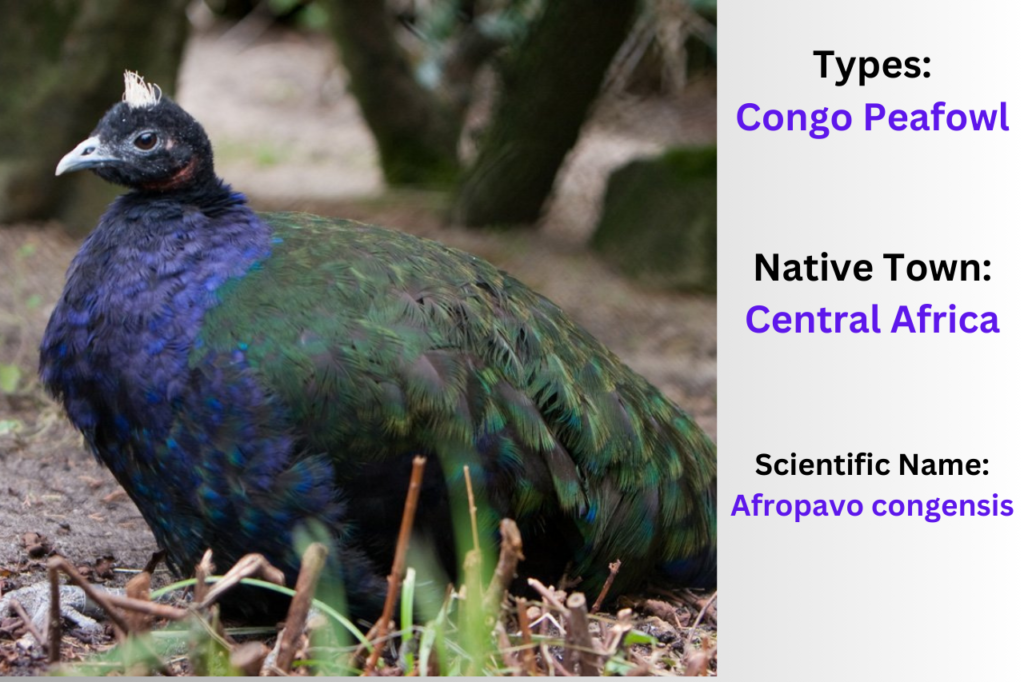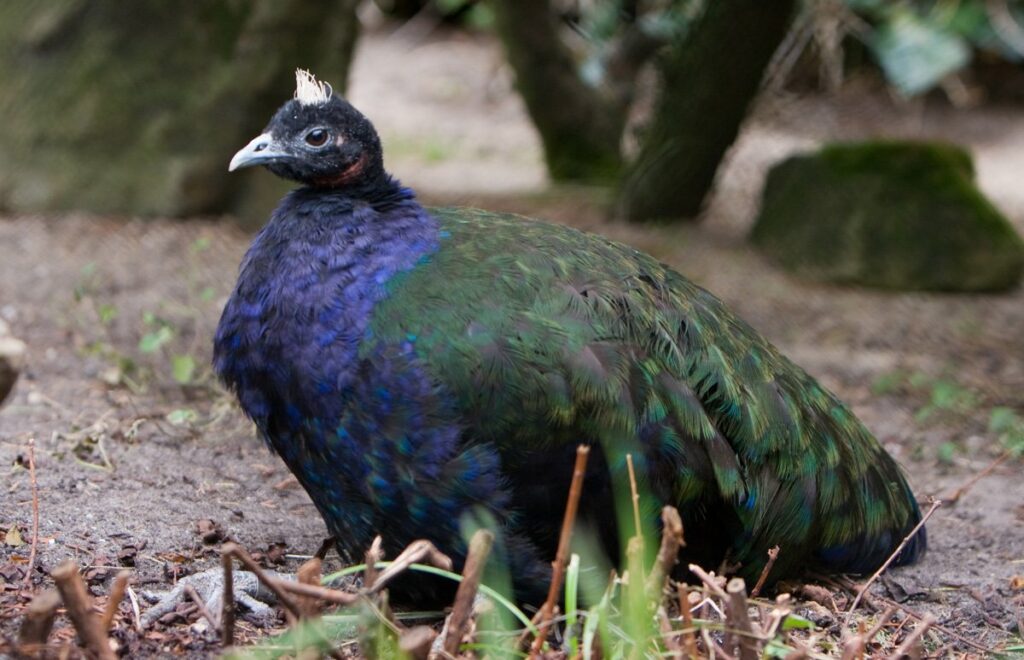
Congo Peafowl
The Congo peafowl, also known as the Afropavo congensis, is a lesser-known but equally captivating member of the peafowl family. While not as widely recognized as the Indian peafowl, the Congo peafowl possesses its own distinct traits and behaviors.

Characteristics of Congo Peafowl
Description
Unlike the vibrant plumage of Indian peafowls, these peafowls exhibit a more subtle yet striking appearance. Both male and female Congo peafowls boast intricate patterns and shades of iridescent blues, greens, and browns across their feathers, albeit in a more understated manner compared to their Indian relatives. Additionally, male Congo peafowls do not possess the exaggerated tail plumage seen in Indian peacocks, but they still display an elegant array of feathers during courtship rituals.
Size
Congos are comparable in size to Indian peafowls, with males typically slightly larger than females. While their tails are not as elongated as those of Indian peacocks, Congo peafowls still possess impressive plumage that adds to their overall size and presence.
Diet
Similar to Indian peafowls, Congo peacocks are omnivorous creatures with a diverse diet. They forage for a variety of foods including fruits, seeds, insects, and small vertebrates, adapting their feeding habits to the available resources in their natural habitat.
Population
The population of Congo peafowl is less well-documented compared to their Indian counterparts. However, they are known to inhabit the dense rainforests and swampy areas of Central Africa, particularly in the Congo Basin region. Due to habitat loss and hunting pressures, Congo peafowls face conservation challenges, and efforts are underway to protect and preserve their dwindling populations.
Lifespan
Congo peafowls have a lifespan comparable to that of Indian peafowls, with individuals typically living for around twenty years in the wild. In captivity, where they are sometimes kept in zoos and wildlife sanctuaries, Congo peafowls may live slightly longer under optimal conditions.
Habitat
As their name suggests, Congo peafowls are primarily found in the forests and wetlands of the Congo Basin in Central Africa. They are adapted to thrive in dense vegetation and humid environments, where they can find ample food sources and suitable nesting sites.
Facts
- The Congo peacocks, although less well-known than its Indian counterpart, plays an important ecological role in its native habitat, contributing to seed dispersal and insect control.
- Like Indian peafowls, Congo have cultural significance in certain indigenous communities, where they may be revered as symbols of beauty and abundance.
- Efforts to study and conserve Congo peafowls are ongoing, with researchers and conservationists working better to understand their behavior, ecology, and conservation needs.
- The Congo peafowl, often overshadowed by its more famous Indian cousin, is a hidden gem of the avian world, quietly captivating those who have the privilege of encountering it in the dense rainforests of Central Africa.

Learning More About the Congo Peafowl
Native to the lush rainforests and swampy habitats of the Congo Basin, the Congo peafowl, scientifically known as Afropavo Congensis, is a species shrouded in mystery and intrigue. Unlike the flashy displays of the Indian peafowl, the Congo peafowl boasts a more understated yet equally mesmerizing appearance, adorned with intricate patterns of iridescent blues, greens, and browns across its feathers.
Behavior
Male Congos, while lacking the extravagant tail plumage of their Indian counterparts, possess an elegance and grace all their own. During courtship rituals, they display their intricate plumage in a mesmerizing dance, captivating potential mates with their subtle yet striking beauty. Females, although less adorned than males, still possess a natural elegance and beauty that perfectly complements their rainforest habitat.
Unique Adaptations
Living in the dense undergrowth of Central Africa’s rainforests, Congo peacocks have developed unique adaptations to thrive in their environment. Their omnivorous diet includes a variety of fruits, seeds, insects, and small vertebrates, allowing them to adapt to the ever-changing resources of their habitat. Their subdued plumage serves as camouflage among the dense vegetation, providing them with protection from predators while allowing them to blend seamlessly into their surroundings.
Conservation Challenges
Despite their remarkable adaptations, Congo peafowls face significant conservation challenges due to habitat loss and hunting pressures. As human activities encroach upon their rainforest habitat, Congo peafowls are increasingly threatened by deforestation and habitat degradation. Additionally, they are hunted for their meat and feathers, further endangering their already vulnerable populations.
Cultural Significance
In indigenous cultures throughout Central Africa, the Congo peafowl holds cultural significance as a symbol of beauty, abundance, and harmony with nature. Its presence in local folklore and traditions highlights its importance as a revered and respected creature within these communities.

Conservation Activities
Efforts to study and conserve Congo peacocks are underway, with researchers and conservationists working tirelessly better to understand their behavior, ecology, and conservation needs. Conservation initiatives focus on protecting their rainforest habitat, raising awareness about their plight, and implementing measures to reduce hunting pressures and mitigate human-wildlife conflicts.
Breeding and Reproduction
During the breeding season, male Congos engage in elaborate courtship displays to attract females. These displays often involve the male showcasing his vibrant plumage while vocalizing to capture the attention of potential mates. Once a pair forms, the female selects a suitable nesting site within the dense undergrowth of the rainforest. She then lays a clutch of eggs, typically numbering between four to six, which she incubates for about four weeks. Both parents play a role in raising the chicks, providing them with protection and guidance as they navigate their rainforest home.
Social Structure and Behavior
Congo peafowls are social birds that often gather in small groups known as flocks. Within these flocks, individuals communicate through a variety of vocalizations, including calls and alarm signals to alert others of potential threats. They also engage in communal roosting, where they gather in dense vegetation at night for protection from predators. Despite their social nature, Congo peafowls can be elusive and are known for their ability to blend seamlessly into their rainforest surroundings.
Conservation Status and Threats
The Congo peafowl faces numerous threats to its survival, primarily due to habitat loss and hunting pressures. Deforestation, driven by agricultural expansion and logging activities, continues to fragment and degrade its rainforest habitat. Additionally, the illegal trade of Congo peafowls for their meat and feathers poses a significant threat to their populations. As a result, the Congo peafowl is listed as Near Threatened on the IUCN Red List, highlighting the urgent need for conservation action to protect this iconic species.
Video about Congo Peafowls
Conclusion
In conclusion, while the Congo peafowl may be lesser-known than its Indian counterpart, it possesses a unique charm and significance within the avian world. As efforts to conserve and protect these magnificent birds continue, there is much to learn and appreciate about the hidden beauty of the Congo peafowl, a true treasure of Central Africa’s rainforests.
